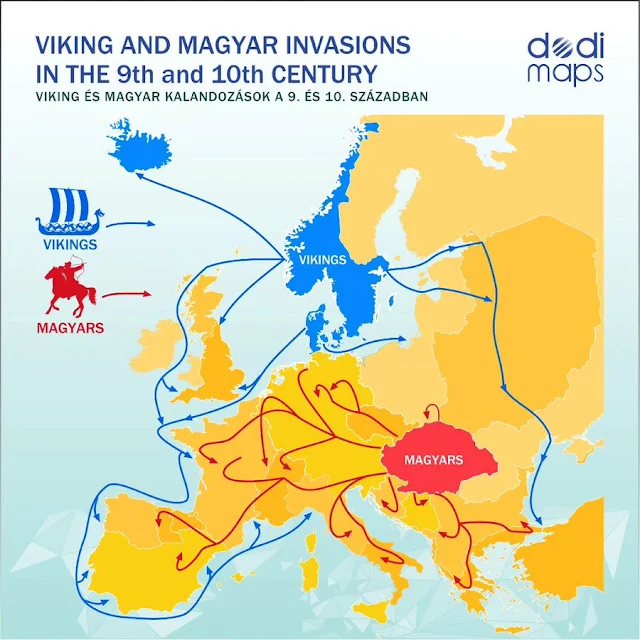Map by Dodimaps
Viking and Magyar invasions in the 9th and 10th century.
The 9th and 10th centuries were a period of significant upheaval and transformation in Europe, marked by the invasions of Vikings and Magyars. These groups, originating from Scandinavia and the Ural Mountains respectively, launched a series of raids and incursions that had a profound impact on the political, social, and cultural landscape of the continent.
Viking Invasions:
The Vikings, skilled seafarers from Scandinavia, began their incursions in the late 8th century, but their activity intensified during the 9th and 10th centuries. Driven by a combination of factors, including overpopulation, a desire for wealth, and a spirit of adventure, they embarked on a campaign of raiding and exploration that took them across much of Europe.
Targets: The Vikings initially targeted coastal areas, particularly monasteries and settlements in Britain and Ireland, which were wealthy and poorly defended. Over time, they expanded their reach, raiding and even settling in areas of France, Spain, and the Mediterranean.
Impact: The Viking invasions had a profound impact on Europe. They disrupted existing political structures, leading to the fragmentation of kingdoms and the rise of new power centers. They also stimulated trade and cultural exchange, as Vikings established trade routes and brought new ideas and technologies to the regions they encountered.
Legacy: The Vikings left a lasting legacy in Europe. Their influence can still be seen in the languages, place names, and cultural traditions of many countries. They also played a role in the development of new political entities, such as the Duchy of Normandy in France and the Danelaw in England.
Magyar Invasions:
The Magyars, a nomadic people from the Ural Mountains, arrived in Central Europe in the late 9th century. They were skilled horsemen and archers, and their military prowess made them a formidable force.
Targets: The Magyars primarily targeted the eastern regions of Europe, raiding and pillaging in areas of modern-day Hungary, Austria, Germany, and Italy.
Impact: The Magyar invasions caused widespread disruption and fear in Europe. Their raids weakened existing political structures and contributed to the fragmentation of the Carolingian Empire.
Legacy: The Magyars eventually settled in Hungary, establishing the Kingdom of Hungary in the 10th century. They adopted Christianity and integrated into the European political system, leaving a lasting legacy in the region.
The Viking and Magyar invasions of the 9th and 10th centuries were a transformative period in European history. These groups, through their raids and incursions, reshaped the political landscape, stimulated trade and cultural exchange, and left a lasting legacy in the regions they encountered. Their impact can still be felt today in the languages, place names, and cultural traditions of many European countries.







Comments
Post a Comment